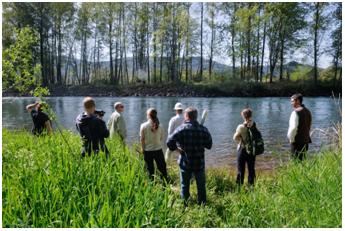My name is Erik Forsell, and a Community and Regional Planning graduate student. I am enjoying the summer weather that has recently arrived, and I am ready to get to work on my exit project over the summer. Currently, my (Community Planning Workshop/CPW) team is working on a program that provides incentives to landowners for protecting healthy riparian habitats along the McKenzie River. The McKenzie is an amazing resource and a beautiful river. It often reminds me of the Mountain Rivers in the Appalachian Mountains, my former home. The McKenzie is the sole source of drinking water for Eugene, and the quality of the drinking water withdrawn from the river is exceptional.
The public utility of Eugene wants to maintain this excellent water. Therefore a voluntary incentive program became the answer to the problem, where landowners can join a program to receive incentives for protecting land that is on the McKenzie. It is a ‘nip it in the bud’ idea, that could also potentially save utility ratepayers and Eugene citizen’s money in the future. This is important because significant scientific evidence suggests that healthy riverside forests do wonders to maintain water quality.
There are myriads of examples of degraded habitats and water-bodies across the country. Unfortunately, the habitat has to become degraded in order for the amazing restoration projects to occur. The program that we are working on seeks to protect and maintain healthy habitats so that the restoration projects will never be needed.
This is an innovative project, which makes it exciting to work on—many of the concepts that are employed are cutting edge in the world of conservation. I am looking forward to seeing how it becomes actualized in our watershed.
About the Author: Erik Forsell is a Community and Regional Planning graduate student with interests in renewable energy and sustainability. He enjoys fishing, skiing and gardening when not working or studying.




